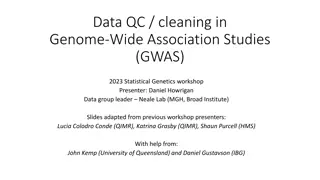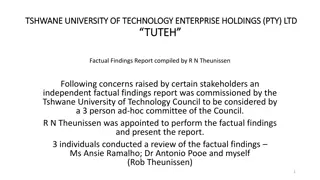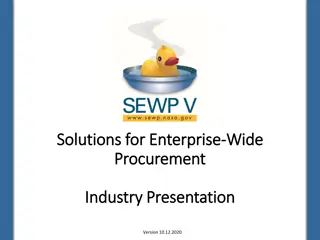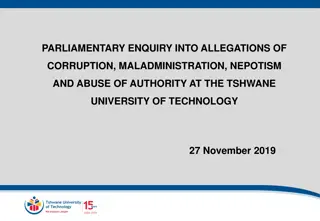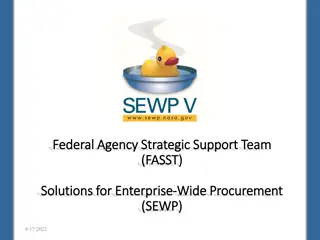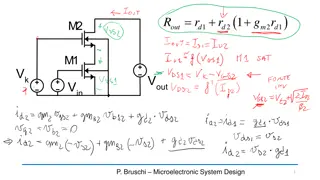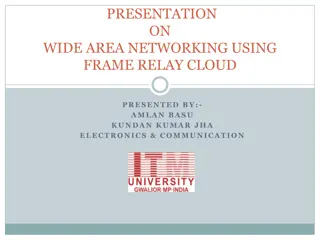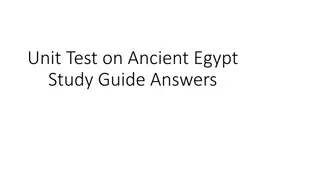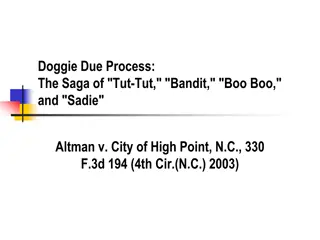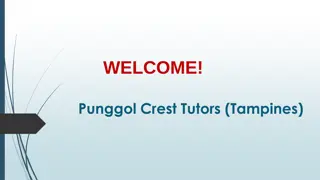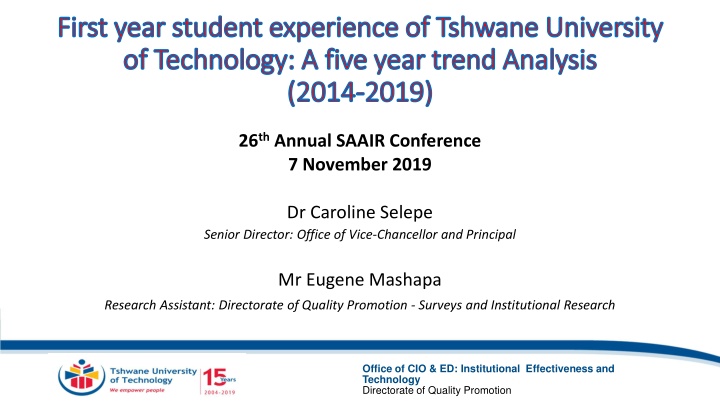
Analyzing First-Year Student Experience Trends at Tshwane University
Explore a five-year trend analysis of first-year student experiences at Tshwane University of Technology from 2014 to 2019. The study delves into the objectives, methodology, findings, and recommendations derived from the First-Year Initial Experience Survey (FYIES) to enhance student support programs and overall first-year student experience.
Download Presentation

Please find below an Image/Link to download the presentation.
The content on the website is provided AS IS for your information and personal use only. It may not be sold, licensed, or shared on other websites without obtaining consent from the author. If you encounter any issues during the download, it is possible that the publisher has removed the file from their server.
You are allowed to download the files provided on this website for personal or commercial use, subject to the condition that they are used lawfully. All files are the property of their respective owners.
The content on the website is provided AS IS for your information and personal use only. It may not be sold, licensed, or shared on other websites without obtaining consent from the author.
E N D
Presentation Transcript
First year student experience of Tshwane University First year student experience of Tshwane University of Technology: A five year trend Analysis of Technology: A five year trend Analysis (2014 (2014- -2019) 2019) 26thAnnual SAAIR Conference 7 November 2019 Dr Caroline Selepe Senior Director: Office of Vice-Chancellor and Principal Mr Eugene Mashapa Research Assistant: Directorate of Quality Promotion - Surveys and Institutional Research Office of CIO & ED: Institutional Effectiveness and Technology Directorate of Quality Promotion
Presentation Overview Presentation Overview Introduction Purpose of presentation Objective of the First-Year Initial Experience Survey (FYIES) Methodology Findings and recommendations Acknowledgements Office of CIO & ED: Institutional Effectiveness and Technology Directorate of Quality Promotion
Introduction Introduction Why surveys are important? Why FYIES? What the study aims to present? Office of CIO & ED: Institutional Effectiveness and Technology Directorate of Quality Promotion
Objective of FYIES Brief profile of TUT TUT is a multi-campus institution located in three provinces and campuses namely: Presentation Overview Conversation around the experience of 1st year students at TUT Should the utilisation of IR results (i.e. FYIES) be mandatory or voluntary? The current analysis seeks to address the latter a) Pretoria, Arcadia, Soshanguve South and North, Garankuwa, eMalahleni, Mbombela (Nelspruit), Polokwane and the Arts Campuses (incl. two teaching centres in CPT and DBN) Objective of FYIES Establish what the first-year students initial experience was in the first (+/-) six weeks at TUT Share the results of the study anticipating that they can be used to: b) Student enrolment on average per year +/- 60 000 a) Inform and enhance transition support programs; and Enhance the total experience of 1styear students b) Office of CIO & ED: Institutional Effectiveness and Technology Directorate of Quality Promotion
Methodology Methodology Longitudinal study (trend analysis of FYIES: 2014-2019) Data was collected through a paper based survey which guaranteed student anonymity during the first 6-8 weeks after student enrolment and registration Questionnaire composed of qualitative and quantitative questions Data was also collected from classes using stratified random sampling Quantitative data was scanned and analysed through Evasys surveys software Qualitative data was captured and analysed using content analysis Reports were generated and presented to management to inform decision-making Questions were also send to various senior managers enquiring their utilisation of IR results to improve their environments efficiency and effectiveness Theoretical lenses used include those laid in the 1970s and 1980s; Tinto (1975;1987), Spady (1970), Bean (1980) and Lewin and Mawoyo (2014) Office of CIO & ED: Institutional Effectiveness and Technology Directorate of Quality Promotion
Key Key factors investigated using factors investigated using the First Year Initial Experience Survey (FYIES) Initial Experience Survey (FYIES) the First Year First-year students orientation programme (structure/content); Orientation programme usefulness; Social and academic integration of first year students; Study habits of first year students; Accommodation and transportation issues; Financial assistance for first year students; and Overall experience of first year students Office of CIO & ED: Institutional Effectiveness and Technology Directorate of Quality Promotion
Findings: Combined quantitative findings Findings: Combined quantitative findings (2014 (2014- -2019) 2019) Office of CIO & ED: Institutional Effectiveness and Technology Directorate of Quality Promotion
Participation rate Participation rate Year 2014 2015 2017 2018 2019 Participation 4020 (27%) 3453 (27%) 4142 (26%) 5114 (34%) 4348 1styear enrolment NB. On average TUT enrols +/- 15 000 15 217 12 989 15 864 14 979 Work in progress Office of CIO & ED: Institutional Effectiveness and Technology Directorate of Quality Promotion
Attendance Attendance of first year orientation programme and orientation activities of first year orientation programme and orientation activities that students would like repeated that students would like repeated 90% 79% 80% 75% 74% 74% 71% 69% 69% 67% 70% 62% 60% PERCENTAGES 52% 49% 50% 38% 40% 33% 31% 31% 29% 26% 30% 26% 25% 21% 20% 10% 0% No 2014 Yes 2014 No 2015 Yes 2015 No 2017 Yes 2017 No 2018 Yes 2018 No 2019 Yes 2019 Did you attend your faculty orientationprogramme for first year students? Would you like some orientation type activities to be repeated later in the year? 26% 74% 26% 74% 21% 79% 25% 75% 29% 71% 52% 49% 62% 38% 33% 67% 31% 69% 31% 69% Office of CIO & ED: Institutional Effectiveness and Technology Directorate of Quality Promotion
Reasons for not attending the 1 Reasons for not attending the 1st styear orientation programme orientation programme year 70% 61% 57% 60% 50% 50% PERCENTAGES 40% 31% 28% 30% 23% 20% 11% 8% 7% 7% 7% 10% 5% 2% 2% 1% 0% 0% 0% 0% 0% 0% 0% 0% 0% 0% 0% Didn't know about orientation Peers said it's a waste of time Joint university after orientation Didn't think is was important Had other commitments 2014 2015 0% 0% 0% 0% 0% 0% 7% 0% 23% 0% 1% 0% 61% 0% 8% 2017 2018 7% 5% 31% 28% 2% 2% 50% 57% 11% 7% 2019 Office of CIO & ED: Institutional Effectiveness and Technology Directorate of Quality Promotion
First year orientation session(s) usefulness First year orientation session(s) usefulness 33% 0.35 32% 31% 0.3 0.25 PERCENTAGES 0.2 18% 17% 15% 0.15 12% 11% 10% 9% 9% 9% 9% 9% 0.1 8% 8% 7% 7% 7% 6% 6% 3% 0.05 3% 3% 3% 3% 3% 3% 2% 2% 2% 1% 1% 0 Keynote address by the Vice Chancellor & Principal Student Developme nt and Support Student Ombudsma n Campus Protection Services Other, please specify Information Sevices Financial Aid Health & Wellness Residences Registrar Sport Percentage ratings of useful activities 2014 Percentage ratings of useful activities 2015 Percentage ratings of useful activities 2017 8% 6% 15% 10% 3% 3% 3% 12% 31% 9% 2% Percentage ratings of useful activities 2018 Percentage ratings of useful activities 2019 11% 9% 6% 9% 33% 32% 9% 8% 3% 3% 2% 2% 3% 3% 7% 7% 17% 18% 7% 9% 1% 1% Office of CIO & ED: Institutional Effectiveness and Technology Directorate of Quality Promotion
Overall experience with the first year orientation programme Overall experience with the first year orientation programme 100% 89% 87% 90% 80% 72% 71% 70% 62% PERCENTAGES 60% 50% 40% 28% 30% 21% 20% 20% 13% 12% 10% 8% 8% 10% 0% Poor Average Good Experience with orientation 2014 Experience with orientation 2015 8% 10% 21% 28% 71% 62% Experience with orientation 2017 Experience with orientation 2018 8% 13% 20% 72% 87% Experience with orientation 2019 12% 89% Office of CIO & ED: Institutional Effectiveness and Technology Directorate of Quality Promotion
Social integration of first year students Social integration of first year students 94% 100% 93% 91% 91% 90% 88% 85% 85% 90% 83% 81% 76% 76% 75% 75% 74% 80% 71% 70% PERCENTAGES 60% 50% 40% 29% 26% 25% 25% 24% 30% 19% 17% 15% 20% 12% 10% 10% 9% 7% 6% 10% 0% Have you attended or participated in any sports events at TUT yet/ Have you made friends at TUT yet? Do you feel at home yet? No 2014 7% 25% 81% Yes 2014 93% 75% 19% No 2015 6% 29% 76% Yes 2015 94% 71% 85% No 2017 10% 24% 85% Yes 2017 90% 76% 15% No 2018 9% 25% 83% Yes 2018 91% 75% 17% No 2019 10% 26% 88% Yes 2019 91% 74% 12% Office of CIO & ED: Institutional Effectiveness and Technology Directorate of Quality Promotion
Social integration of first year students (cont.) Social integration of first year students (cont.) 100% 91% 88% 87% 87% 84% 90% 77% 76% 75% 75% 80% 72% 65% 70% PERCENTAGES 60% 60% 53% 52% 51% 49% 48% 47% 50% 41% 35% 40% 28% 25% 25% 24% 23% 30% 16% 13% 20% 13% 12% 9% 10% 0% Have you joined any clubs/associates yet? E.g choirs, debating society etc Do you understand how the university works? Have you personally spoken to any lecturers yet? No 2014 87% 23% 41% Yes 2014 13% 77% 60% No 2015 84% 25% 35% Yes 2015 16% 75% 65% No 2017 88% 24% 52% Yes 2017 12% 76% 48% No 2018 87% 25% 49% Yes 2018 13% 75% 51% No 2019 91% 28% 53% Yes 2019 9% 72% 47% Office of CIO & ED: Institutional Effectiveness and Technology Directorate of Quality Promotion
Academic integration of first year students Academic integration of first year students 100% 87% 86% 85% 84% 90% 78% 80% PERCENTAGES 63% 62% 70% 59% 56% 55% 55% 53% 53% 60% 52% 51% 49% 49% 47% 47% 45% 45% 44% 50% 41% 38% 37% 40% 22% 30% 17% 15% 14% 13% 20% 10% 0% Have you personally spoken to a mentor/tutor yet? Do you know where Student Development and Support (SDS) offices are in your campus? Have you been to Student Development and Suport (SDS) yet? No 2014 49% 47% 84% Yes 2014 No 2015 51% 49% 53% 44% 17% 78% Yes 2015 No 2017 52% 59% 56% 45% 22% 86% Yes 2017 No 2018 41% 55% 55% 47% 14% 85% Yes 2018 No 2019 45% 63% 53% 38% 15% 87% Yes 2019 37% 62% 13% Office of CIO & ED: Institutional Effectiveness and Technology Directorate of Quality Promotion
Academic integration of first year students (cont.) Academic integration of first year students (cont.) 100% 87% 86% 85% 84% 84% 90% 79% 74% 74% 73% 80% 69% PERCENTAGES 70% 60% 50% 40% 31% 27% 26% 26% 30% 21% 17% 16% 15% 14% 13% 20% 10% 0% Do you know what the lecturers expect of you? Are you worried about your term/semester tests? No 2014 13% 26% Yes 2014 No 2015 87% 15% 74% 31% Yes 2015 No 2017 85% 14% 69% 27% Yes 2017 No 2018 86% 16% 73% 26% Yes 2018 No 2019 84% 17% 74% 21% Yes 2019 84% 79% Office of CIO & ED: Institutional Effectiveness and Technology Directorate of Quality Promotion
First year students study habits First year students study habits 60% 51% 51% 50% 48% 50% 46% 40% PERCENTAGES 34% 32% 31% 31% 31% 30% 20% 12% 12% 11% 10% 10% 10% 5% 5% 5% 5% 4% 4% 4% 3% 3% 3% 0% Less than 10 hours 10-15 hours 15-25 hours 25-35 hours More than 35 hours 2014 2015 2017 46% 51% 34% 31% 12% 10% 5% 4% 3% 3% 48% 50% 31% 31% 12% 11% 5% 5% 4% 4% 2018 2019 51% 32% 10% 5% 3% Office of CIO & ED: Institutional Effectiveness and Technology Directorate of Quality Promotion
Accommodation and transport Accommodation and transport Are you happy with where you live while studying? 2014 53% were happy where they live 48% were not happy with where they live 2015 52% were happy where they lie 48% were not happy with where they live 2017 47% were happy where they live 53% were happy with where they live 2018 51% were happy where they live 50% were not with where they live 2019 57% were happy where they live 43% were not happy with where they live Where do you live while studying? 45% 39% 40% 37% 35% 30% 29% PERCENTAGES 30% 28% 27% 27% 27% 26% 24% 23% 25% 22% 21% 20% 20% 16% 15% 9% 8% 8% 10% 7% 7% 7% 6% 6% 6% 6% 5% 5% 4% 4% 4% 3% 3% 3% 3% 3% 5% 0% University residence Sharing a flat/apartment No At home With relatives Commune Other accommodation 2014 2015 27% 29% 22% 6% 7% 3% 6% 27% 30% 28% 20% 24% 26% 6% 7% 9% 8% 4% 7% 3% 3% 2017 2018 23% 16% 37% 39% 21% 27% 5% 3% 6% 8% 5% 4% 3% 4% 2019 Office of CIO & ED: Institutional Effectiveness and Technology Directorate of Quality Promotion
Accommodation and Accommodation and transport (cont.) transport (cont.) How far, from where you take your transport, do you live from campus? 33% 35% 29% 29% 29% 28% 28% 30% 27% 24% 25% 23% 22% 22% 22% PERCENTAGES 19% 18% 20% 18% 17% 17% 15% 14% 14% 13% 13% 15% 12% 9% 10% 8% 5% 0% A short drive away (0-30 minutes) A 30-60 minutes drive from campus A long drive away (more than 60 minutes) On campus Within walking distance 2014 2015 17% 13% 9% 13% 19% 23% 22% 27% 28% 29% 28% 29% 22% 22% 24% 18% 15% 12% 18% 14% 2017 2018 2019 14% 29% 33% 17% 8% Office of CIO & ED: Institutional Effectiveness and Technology Directorate of Quality Promotion
Accommodation and transport (cont.) Accommodation and transport (cont.) 0.35 Transport Problems 30% 2014 29% 0.3 68% of respondents don t have transport problems 32% of respondents have transport problems 2015 68% of respondents don t have transport problems 32% of respondents have transport problems 2017 58% of respondents don t have transport problems 42% of respondents have transport problems 2018 66% of respondents don t have transport problems 34% of respondents have transport problems 2019 74% of respondents don t have transport problems 27% of respondents have transport problems 25% 0.25 21% 21% PERCENTAGES 20% 19% 19% 0.2 18% 17% 15% 15% 15% 14% 0.15 12% 0.1 4% 3% 0.05 3% 0 Bus timetables are not suited for my classes Buses are always late Bus intervals are too far apart Buses are always full Bus drivers are not friendly Other, specific reasons 2014 2015 2017 2018 2019 15% 15% 19% 19% 29% 25% 15% 17% 3% 4% 18% 21% 12% 20% 30% 14% 3% 21% Office of CIO & ED: Institutional Effectiveness and Technology Directorate of Quality Promotion
Financial assistance Financial assistance Have you applied for financial assistance and if not please provide reasons why? 84% 0.9 83% 0.8 0.7 59% PERCENTAGES 55% 55% 0.6 50% 45% 0.5 41% 38% 0.4 31% 30% 27% 0.3 17% 16% 14% 0.2 11% 10% 10% 7% 6% 5% 0.1 3% 3% 0 Did not know about other sources of financial assistance Assumed admission to university gaurantees financial assistance Applied for financial assistance Did not apply for financial assistance Parents are paying tution fees Missed application deadline Other specific reasons 2014 2015 2017 55% 45% 59% 17% 41% 83% 30% 50% 14% 7% 38% 31% 11% 10% 6% 3% 2018 2019 16% 84% 55% 5% 27% 10% 3% Office of CIO & ED: Institutional Effectiveness and Technology Directorate of Quality Promotion
Financial assistance Financial assistance (cont.) (cont.) 80% 71% 70% 65% 60% 52% 47% 47% PERCENTAGES 50% 44% 40% 29% 30% 25% 22% 20% 18% 18% 20% 14% 9% 10% 5% 4% 3% 2% 2% 1% 1% 1% 1% 1% 0% Awaiting response from NSFAS or other bursary NSFAS Other bursaries Employer Private (e.g Parents) 2014 2015 2017 47% 22% 5% 4% 1% 1% 47% 44% 29% 52% 65% 3% 2% 1% 1% 20% 14% 25% 18% 2018 2019 71% 2% 1% 9% 18% Office of CIO & ED: Institutional Effectiveness and Technology Directorate of Quality Promotion
Overall satisfaction of first year students Overall satisfaction of first year students Would you choose TUT again if you had to choose again and please rate your experience here at TUT 100% 86% 84% 90% 80% 76% 75% 80% 69% 68% 70% PERCENTAGES 58% 57% 60% 53% 50% 37% 35% 40% 33% 32% 31% 25% 24% 30% 20% 16% 14% 20% 11% 9% 8% 10% 0% No Yes Poor Average Good 2014 2015 2017 25% 31% 75% 69% 9% 11% 33% 37% 58% 53% 20% 24% 80% 76% 8% 14% 35% 57% 86% 2018 2019 32% 68% 16% 84% Office of CIO & ED: Institutional Effectiveness and Technology Directorate of Quality Promotion
Findings: Combined qualitative findings (2014-2019) Office of CIO & ED: Institutional Effectiveness and Technology Directorate of Quality Promotion
Unhappiness with accommodation and transport Unhappiness with accommodation and transport Accommodation Unsuitable student accommodation in surrounding areas Lack of university of accommodation Challenges with sharing accommodation (asocial roommates) Unregulated student accommodation (too much noise and interruptions) Problems with sharing accommodation (social compatibility) Transport Safety and security concerns (walking) Transport costs (taxi and bus fare) Have to walk long distances (cannot afford bus and taxi fare) Too much time spend on traveling University transportation do not reach some destinations Bus timetables do not compliment class timetables Office of CIO & ED: Institutional Effectiveness and Technology Directorate of Quality Promotion
What do you like about TUT? What do you like about TUT? The academic environment Academic staff (lecturers, mentors and tutors) Services provided by the university (LISs, ERC, transportation services and safety and Security) The Student Development and Support (SDS) services The admission requirements of the institution The presence of international students Sporting facilities Affordable tuition fees Office of CIO & ED: Institutional Effectiveness and Technology Directorate of Quality Promotion
Overall satisfaction of first year students Overall satisfaction of first year students Reasons for not choosing TUT again choosing TUT again ways TUT can improve ways TUT can improve Reasons for not Reasons for not coming back Not desired course Prefers other institutions Poor or lack of accommodation Library too small to accommodate majority of students Lack of university accommodation Academic interruptions (strikes) Limited extracurricular activities (e.g. sports) Ways TUT can improve Increase tutorials and the number of mentors and tutors Expand the outreach and operational effectiveness of the financial aid office Increase university accommodation Create more sporting facilities Increase transport services Create feeding scheme for disadvantaged individuals Campus management should consider expanding campus facilities (library and lecture halls) Expand the outreach of financial aid s Office of CIO & ED: Institutional Effectiveness and Technology Directorate of Quality Promotion
Conversation with senior managers Conversation with senior managers 3 senior managers were asked whether their environments utilise IR results to inform decision-making Two senior managers responded Other senior managers did not respond From the response of the two senior managers, it was revealed that: a) FYIES results and recommendations are utilised to improve departmental processes and services for students For instance: The annual self-reflection for TUT 101 team uses FYIES findings and recommendations for improvement of the 1st year orientation programme And marketing of SDS improved Suite of services rendered by SDS improved across campuses TUT101 Programme Improved planning of 1st year orientation programme by faculty marketers and orientation champions Value added to sustenance of positive attitude toward TUT101 project over 5 years Stakeholders appreciates impact of their efforts Student Development and Support (SDS) use of findings and recommendations for: 1. Review its suite of student support services 2. Restructuring purposes 3. Resource planning and allocation 4. Prioritisation of services 5. Tracking impact of support services across campuses Office of CIO & ED: Institutional Effectiveness and Technology Directorate of Quality Promotion
Conversation with senior managers Conversation with senior managers (cont.) (cont.) The IR results and recommendations assists their environments to understand the financial, social and basic challenges which students experience daily The results also help assess and trace students progression in their respective academic programme The social aspects of student life and involve the support units such as SDS for further assistance IR results: a) create and improve communication platforms between faculty staff, student leaders and first year students; b) help the different faculties of the institution in planning remedies to deal with homesickness, students depression, and survival strategies; c) help us put the right senior students at various help desks on campus to assist and welcome the first years; and d) can be used as instruments utilized to solicit relevant assistance such as writing skills and exam preparation mentors to guide our students. Office of CIO & ED: Institutional Effectiveness and Technology Directorate of Quality Promotion
Discussion Discussion We can conclude that currently there is no mandatory obligation compelling managers to use IR results and recommendations for decision-support and strategic planning Institutional effectiveness and efficiency is the result of utilising IR findings and results to compliment quality management principles, to inform strategic planning, policy formation and decision-support The question to the IR community today is how can IR offices ensure IR findings and recommendations become mandatory? Office of CIO & ED: Institutional Effectiveness and Technology Directorate of Quality Promotion
Conclusion Conclusion From the submissions by respondents it can be said that overall the academic environment of TUT campuses is satisfactory The quality of education and the academic staff of all campuses was highly applauded by respondents The majority of first year students from all three campuses (2014=38%, 2015=22%, 2017=52%, 2018=64%, 2019=70%) received financial assistance from NSFAS Respondents also highlighted their frustrations regarding the sizes of the libraries, lecture halls and the layout of campuses University accommodation continues to be a major challenge with respondents from the majority of campuses calling for the expansion of university residences Nonetheless, overall the majority of students who participated in the FYIES during the past five years are satisfied with TUT was Office of CIO & ED: Institutional Effectiveness and Technology Directorate of Quality Promotion
Recommendations Recommendations It was suggested by respondents that all three campuses should expand their library facilities It was also suggested that, more sporting facilities should be created The university should erect more accommodation for students (specifically for eMalahleni and Polokwane) Bus timetables should correlate with class timetables (Expand university transport services) Respondents from all campuses called for more tutorials and student outreach programmes Expand campuses (lecture halls and libraries) Erect more university accommodation Provide study materials on time Instil a positive work ethic amongst TUT staff Provide microphones inside lecture halls and podcasting of lectures on myTutor for students to view in their own convenient time) Office of CIO & ED: Institutional Effectiveness and Technology Directorate of Quality Promotion
Acknowledgements Acknowledgements Staff and management All first-year students (2014-2019) Directorate of Quality Promotion: Office of Surveys and Institutional- Research Office of CIO & ED: Institutional Effectiveness and Technology Directorate of Quality Promotion
Thank you Thank you Office of CIO & ED: Institutional Effectiveness and Technology Directorate of Quality Promotion
Questions/Comments Questions/Comments While universities cannot impact on all the factors influencing student success, they can pay serious attention to the quality and status and status of teaching and learning (Lewin and Mawoyo, 2014) Office of CIO & ED: Institutional Effectiveness and Technology Directorate of Quality Promotion


